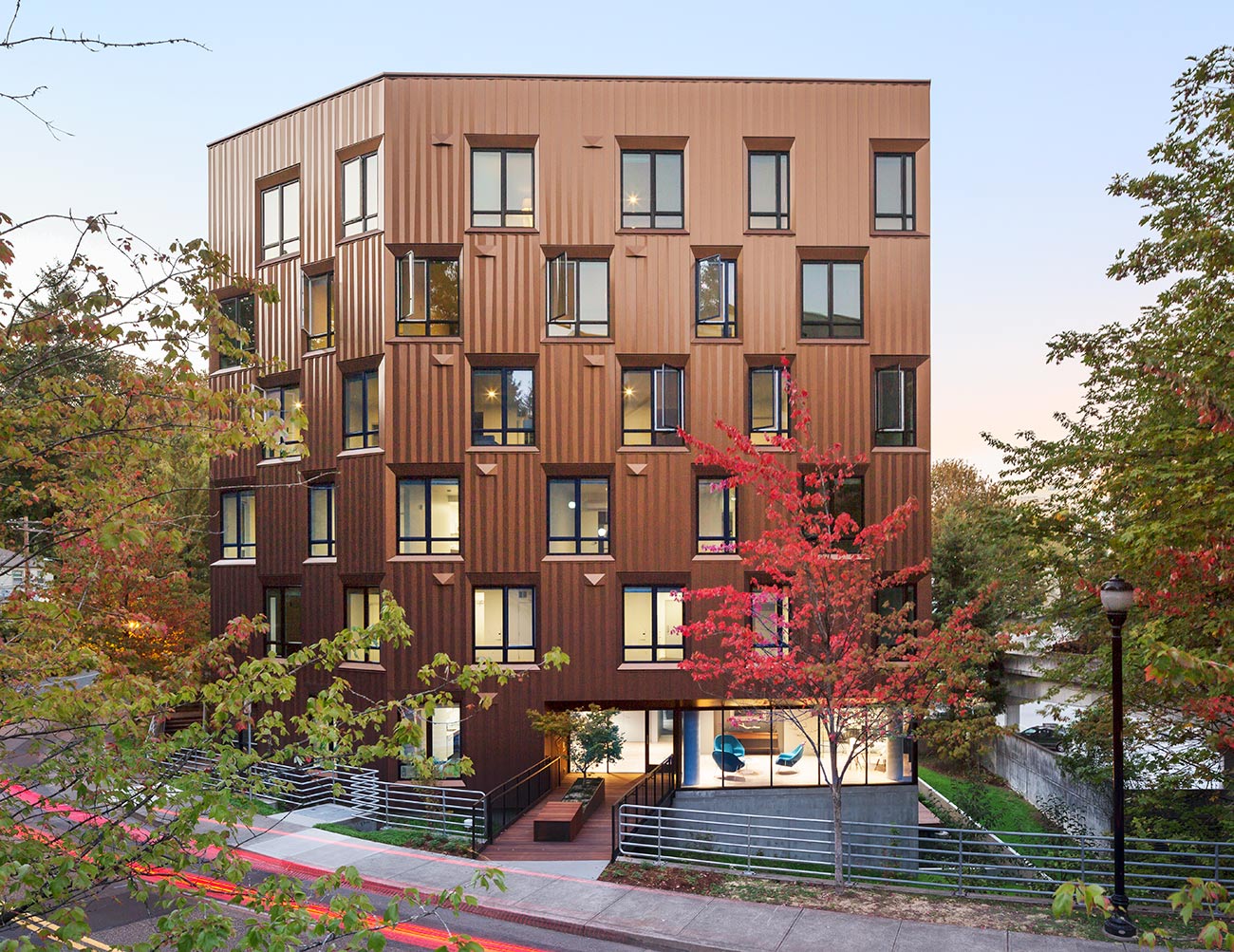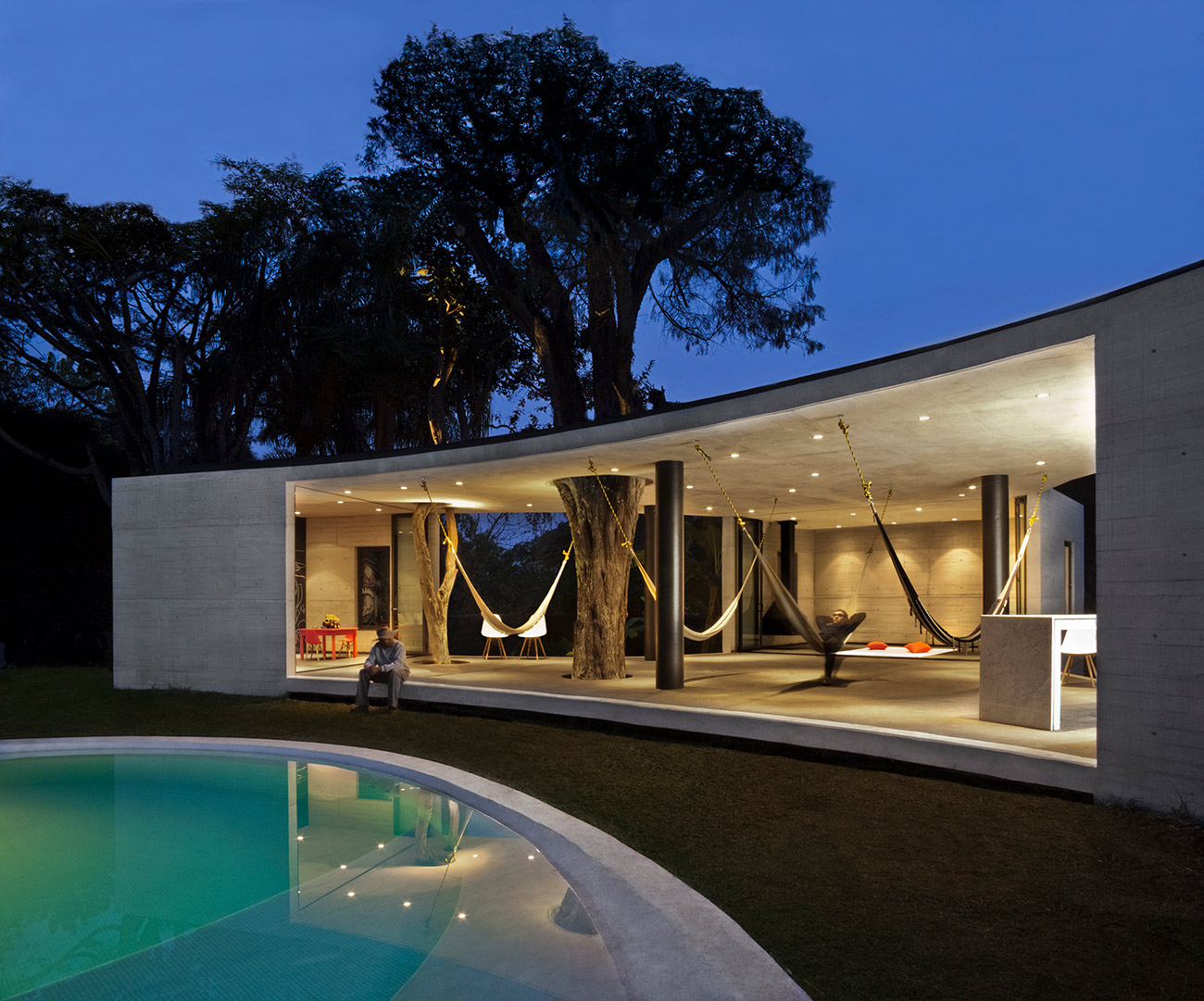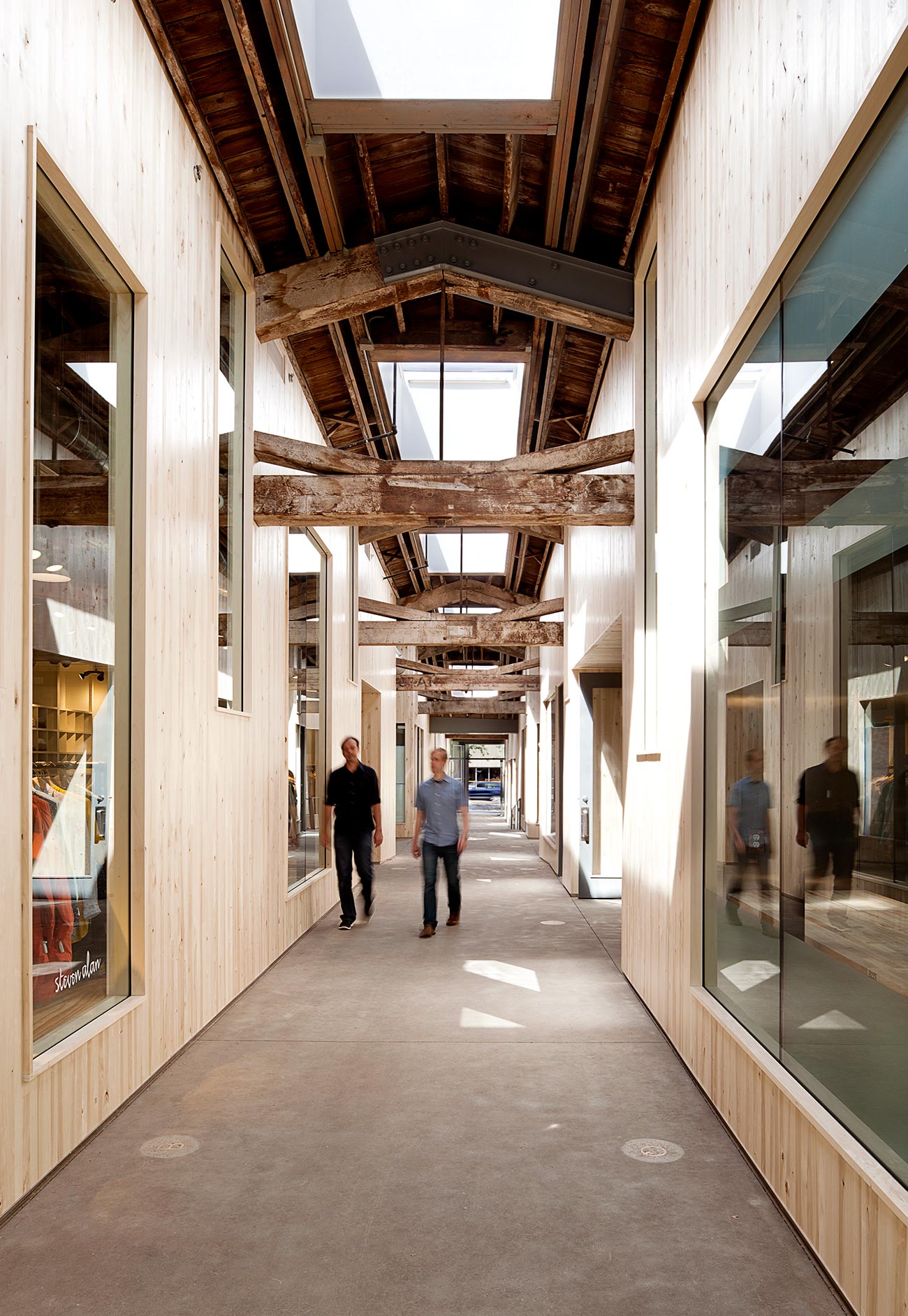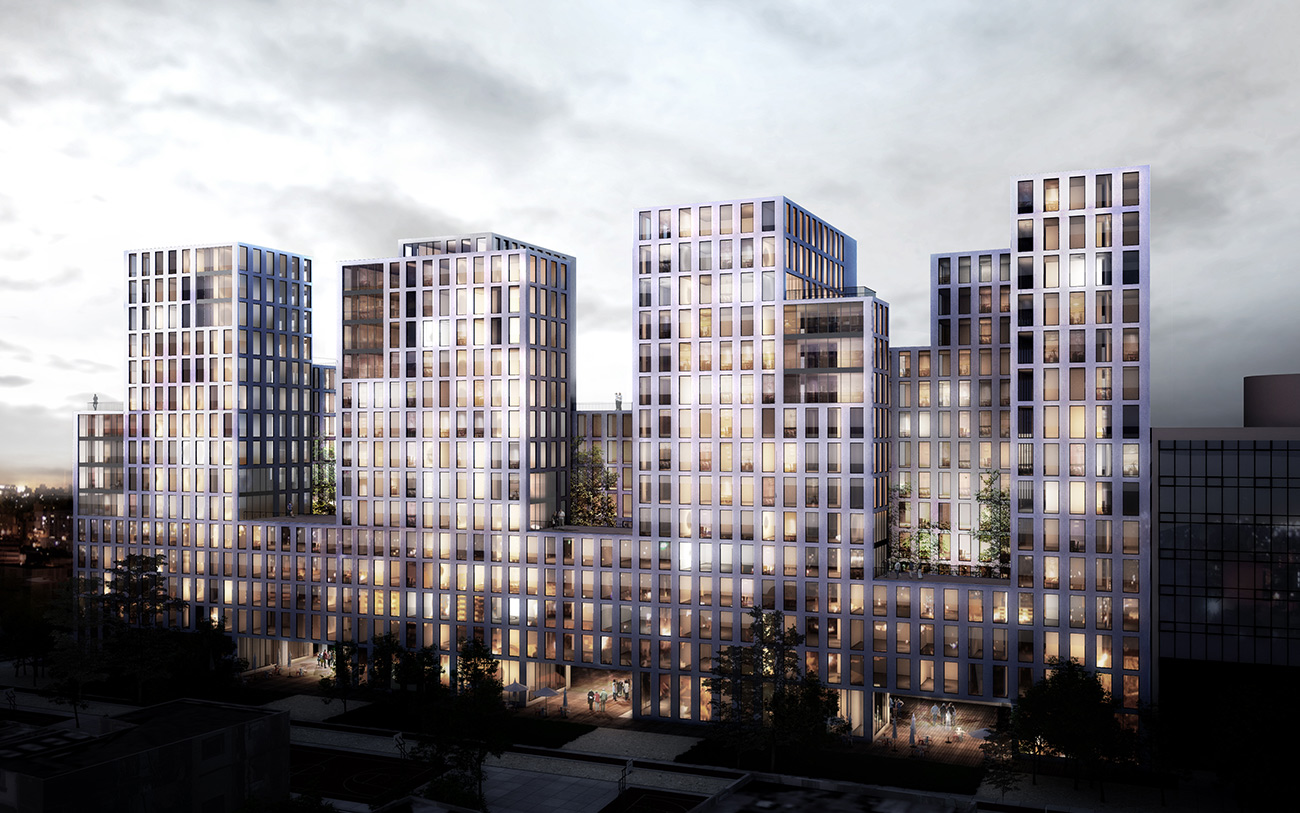On the table: Dinner with Eduardo Cadaval, Clara Solà-Morales, and Thomas F. Robinson
Emerging Voices winners discuss timber construction, architectural ethics, and the value of design.
The League’s annual Emerging Voices program recognizes eight firms with distinct design voices. In March and April, each firm delivers a lecture, then joins prominent architects, critics, and others in the industry for dinner and informal discussion.
The following conversation features the founders of Barcelona and Mexico City–based Cadaval & Solà-Morales and Portland-based LEVER Architecture.
Lisa Gray, Gray Organschi Architecture: Both firms have immersed themselves in the practical realities of construction, while also trying to solve pressing social issues through the realization of buildings. How did you come to that position? What in your background brought you to that?
Eduardo Cadaval, Cadaval & Solà-Morales: I think arriving at this position was easy for us, because we always wanted to build. We didn’t want to become an office that only created beautiful drawings. We’re not against that, of course, but we are more interested in building. And in our situation, one must work with simplicity and simple construction techniques – that was the basis for discourse that we then built upon.
When Thomas presented his work, though, I have to say that I was jealous, because we cannot build with wood in Mexico.
Clara Solà-Morales, Cadaval & Solà-Morales: We’ve also become very pragmatic, which is funny, because I tried to escape a very pragmatic education by coming to the United States for more inspiration. So I find myself returning to pragmatism within another context.
To add to what Eduardo said, it’s about how we’re reclaiming architecture. To talk about architecture is not to talk about semiotics anymore, for instance, but to talk about space. Talking about semiotic representation is useful, but does not address what architecture is intended to: inhabitation, space, materiality.
Thomas F. Robinson, LEVER Architecture: I worked for Joseph Esherick straight out of undergrad. He always asked, “How would a farmer do it?” Which I always understood as, How do you accomplish the most, with the least, and without waste?
Joe designed the woodshop at UC Berkeley, which is the nicest space in the entire school, and I learned how to weld, how to work wood, all for relatively little. There were master craftsmen to guide our work, and I also learned enough about each of those disciplines to appreciate them.
I ended up producing this slightly odd architectural sculpture my senior year, which I submitted for awards. Classmates were upset when I won because they did not consider my material explorations to be architecture.
Looking back, I realize that there’s something incredibly valuable to understanding those types of explorations on a material level – it’s what ultimately led me to where I am today. I basically spent three years developing the metal facade for the de Young Museum. And now it’s kind of ironic that people see me as the wood guy.
Gray: Clara and Eduardo, I enjoyed the 10-second run-through of the last 100 years of architectural pedagogy in your presentation. When I was educated in the 1980s, there was a lot of looking outside the boat, as it were, from architecture to construction, from architecture to literary theory, from architecture to semiology. They were attempts to grab meaning from other disciplines, which produced some interesting conversations.
I am inspired by both firms’ ability to really grab onto architecture’s own special tools. It’s really amazing. You guys are talking about a kind of pragmatism in deploying those tools in the service of beautiful built work.
Cadaval: Clara and I were saying earlier that we’re very conservative in terms of the projects we choose to take on, because we want to be sure that they are a part of a discourse that interests us. That means some sort of sacrifice in terms of money or office size. When we started doing small houses, we realized that those projects only provide so much financial stability. And those few moments when we took on larger projects, we were like, “Oh man! Financial stability for the office for an entire year!” We just got used to having a very small practice.
Solà-Morales: Yes, as a practice we have made certain polemical decisions. Eduardo is Mexican and I am Spanish, and we both practice in our own countries on different continents, due to an ethical understanding of how architecture operates for both of us. We believe that, with our education, we have an obligation to give back to our original communities. It’s not about the place that you were born, but it’s that we’ve been lucky enough to study at the Harvard GSD, one of the best universities in the United States. We’ve been given so many opportunities and we need to give back! That means building a society, or building the architecture to build a society, in those places.
Martin Finio, Christoff:Finio Architecture: Clara used the word reclaim, which I think is a great word applicable to both firms. There is a kind of reclamation, in the obvious sense – but I also think that both firms sought to reclaim the profession. Thomas’s wood buildings are so clear – there’s something so straightforward in the idea of a thick wooden column, with a thick wooden lintel, with a thick wooden slab, repeated, to make a building. And there is Eduardo and Clara’s idea that you don’t need anything more than concrete and glass to create brilliant spaces. I love this feeling of reclamation as a way of taking back the profession, taking back the idea of what architecture really means.
Solà-Morales: There’s still so much that has to be done. Somehow, as a profession, the architect has become unimportant in the construction of the city. We need to empower ourselves and reclaim the point of view that we are still useful, that we can help construct something that builds our cities. Somehow we’ve been erased from that position, or we’ve fallen into an architecture of architects only.
Robinson: Most of my projects are with for-profit developers. We explore how we can both serve a civic purpose but also create value. At the end of the day, that’s what the developer wants to see. There is one developer who I work with and who has a degree in urbanism. In the end, if the project doesn’t generate revenue, we’ve failed. But I do know that we’ve been able to finish projects that actually create a huge amount of value – he’s sold them at a much higher market value because of the design.
Gray: It turns out that good architecture is valuable.
Robinson: It’s fundamental, at least in the environment where I work right now. There is also the public side of this, which I don’t discount, but on the private side innovation works.
Cadaval: It seems so difficult to both add value and produce good architecture in the US. The building codes are unbelievable. How do you navigate them and manage to innovate when you have to constantly fight with all those codes? In Mexico, we’re not as constrained, so to me, you guys are heroes.
Taryn Christoff, Christoff:Finio Architecture: Thomas spoke of the phrase “forest to building, forest to frame.” There is something very local about the work that you’re doing – it is very site specific, very specific to Portland, and maybe, to some degree, to Los Angeles.
And Clara and Eduardo, I really appreciated the kind of matrix from Mexico City to Barcelona and the differences in the work. There is, again, something very local about it. When you lived in New York, did you do any work here?
Solà-Morales: We met during our studies at the GSD, and before deciding where we would move, we spent some time in New York. Eduardo was working at Field Operations and I was working at TEN Arquitectos. We both decided this was not the place to stay.
Cadaval: That had to do with how cheap it was to start an office in Spain and Mexico.
Solà-Morales: It’s not only that, I think. While in New York, I was able to experience, in a couple years, the entire design process through construction. But I also witnessed, at the desk next to mine, how they were fighting against reality and how huge, amazing projects had become . . . I’m not going to say terrible, but fell short of original expectations. Our decision to leave New York had to do with a gratitude toward our involvement in amazing projects, but also a longing for more freedom.
Robinson: I want to address building codes, because I don’t actually talk about them very much, but I always work with them from the beginning. On a lot of our projects, I don’t even start any design work until I have first checked the codes.
I start with the constraints. If you’re going to play tennis, for example, whether you are playing singles or doubles changes the constraints of the court. If you are playing singles on the doubles court, you’re going to get destroyed.
Gray: I think that’s very well said. When you understand the parameters you can create within them in an innovative way. But I do think the fact that architecture in the US is totally product-based creates a huge difficulty. It may be creeping into other parts of the world, unfortunately: northern Europe in particular.
The direct relationship Eduardo and Clara have with their builders, there’s something very old-fashioned about that for those of us based in the US. Builders are interpreting your drawings and delivering the project. It’s not just about the process of assembly, which is now most of what happens in the US.
Solà-Morales: In Mexico, labor is very cheap, and so you base your design on labor, basically. In Europe, labor is more expensive and so the more prefab, the cheaper the project will be. And in the US, where labor is still more expensive than in Europe, I understand that prefab is the way to go. There really isn’t a lot of space to move around.
Adam Yarinsky, Architecture Research Office: Despite the fact that both practices ostensibly don’t do work in the public realm, I’m impressed by how connected to place and how public the work actually is, especially considering the political environment we are entering. It reminds us of the necessity to think about that dimension.
Neither of you presented projects that were public in the traditional sense of the word, so I’m curious to see what you’d do in that realm, or if you have done things that we don’t know about.
Robinson: In a way, many decisions are already made for us. The market in Oregon is driven primarily by development and by a very farsighted group of people back in the 1970s who established comprehensive urban planning over the entire state, including an urban growth boundary in every city. This is a state law, so it allows for the planning of Oregon as a whole. Additionally, there is a law that maintains working timberlands in rural parts of Oregon. These two pieces of legislation, in many respects, allow us to do the innovative timber work that we do there.
Unlike many others, the state building department in Oregon has ultimate code jurisdiction over our cities, but the department typically doesn’t exercise it unless there is a good reason. The state is just out there saying, “Hey, this is a really important project and we want to try and establish a standard for the entire state, we don’t want it to be piecemeal.”
Andrew Bernheimer, Bernheimer Architecture: I’m interested in the local jurisdictional aspects of building relative to the politics of our current moment. I’m curious to know about your experience with federal research grants and what you foresee in the next few years. Is there enough momentum through other means in the absence of potential federal support?
Robinson: For people who don’t know – or rather, for those who aren’t as big of a wood geek as I am – the question is really, will the federal government continue to support innovation in timber? And, if they don’t, is the private sector going to fill the void?
I honestly think it would. There are a lot of people investing serious money and venture capital into mass timber. And they’re not contractors – they’re from the tech industry.
What’s interesting about our Framework project is that the financing is just as complex as the fire testing we are doing. But I will say that there are some big mass timber and CLT projects in the pipeline.
Brad Samuels, SITU: I want to push the political question further. I find it interesting that, in both firms, pretty radical political propositions are almost a footnote. On the one hand, Thomas, mass timber could be an economic driver in the heartland, a way to address much bigger and more urgent questions. And for Eduardo and Clara, there is a radical disengagement from public projects, which you say are mostly corrupt. How committed are you to those ideas? Are they footnotes or are they really important parts of your practice?
Cadaval: Our taste is a very important part of our practice. The only good thing to come about from President Trump’s relationship to Mexico is an understanding that we also have big problems, or that Mexico treats the immigrants from Central America in the same way that the US treats Mexican immigrants. Mexico is also a very corrupt country—so corrupt that my kids live in Barcelona.
At the very least, we can choose not to participate. In our case, it’s not a footnote at all. We don’t do it; we hate it. Many of my colleagues in Mexico City participate in the system because they argue that either they play or someone else will play, and then the environment will be even worse.
On the other hand, and this is what we need to learn from the US, we’re trying to push the agenda as a civic society. How can we develop civic projects through private fundraising? That’s a situation unique to the US. How can private money fund good initiatives? We don’t have that sort of culture in Mexico. We would love to do public projects in Mexico, but we will not do them unless there’s a fair way to do them.
Rosalie Genevro, The Architectural League of New York: That’s a good question, and it’s relevant to our situation here right now. Recognizing that situation, do you see your responsibility as an architect/citizen as going beyond what is specifically architectural, in any way?
Cadaval: Yes and no. It’s very difficult to find the way to do it. One of my best friends, who works with immigrants and their rights in southern Mexico, wanted to build a shelter. So we offered our expertise as architects. Our clients for the Sunflower House in Spain are two lawyers for the International Court of Justice. They want to build a hotel and a shelter for refugees, with the intention that the refugees will work at the hotel.
So there are instances when we do pro bono work. I don’t find social media activism effective, so I offer my expertise as an architect where I can. I think there is a very different climate in the US – civil society is much more active.
Solà-Morales: A while ago when you were talking about Portland, I thought to myself that, while we do put our ethics ahead of our practice, we aren’t helping to build an architectural lobby. It’s interesting that you’re okay with the fact that every civic project in Portland comes from the private sector. Why aren’t architects standing up for specific government policies related to public space? Why is it that we, as architects, have sold ourselves to the private sector and don’t care about what’s going on in politics? Is it because it’s too late?
Robinson: It’s a great question. And because of the material that I’m working on and the place where I live, wood is incredibly political. Last Friday, I testified before various environmental committees at the state legislature about mass timber funding. In Washington State, legislators recently passed a bill to fund CLT–based classroom work. We’ve basically had every member of Oregon’s congressional delegation visit Albina Yard so that we can talk about mass timber.
At the same time, many of the people I have worked with in rural Oregon have very different political views. But we work well together because we have a connection that isn’t based on politics.
Christopher Sharples, SHoP Architects: Yesterday I read in the Guardian that the Timber Innovation Act is on the table in the US House and Senate. If there is one thing that comes out of this administration, it might be taking a traditional material and bringing it to the 21st century.
The fact is, and Thomas you mentioned it earlier, that architecture can play a big role in the private sector in terms of adding value. Developers see that now, and what’s great is that architects are leading the charge. Science is coming back into the conversation – it’s not just about aesthetics anymore. As long as we perform really well, we know it’s going to look beautiful.
At the end of the day, that’s what we all want. If something is beautiful, people are going to take care of it and care about it, and that’s the most sustainable thing you can ask for.
Right now we’re in this period in which architects have to focus on the science, whether it’s technology or new materials. I can tell you that this is the best time to be an architect.
Explore
Interview: SITU Studio
The Brooklyn firm combines design, fabrication, and research to explore a broad range of spatial issues.
Material flows, ecosystem growth, and urban landscape renewal
Paul Mankiewicz explores ways to improve the environmental, infrastructural, and economic health of cities.
Architecture does not stop at the roof
Fernanda Canales, a winner of the 2018 Emerging Voices competition, writes about her architectural education.








